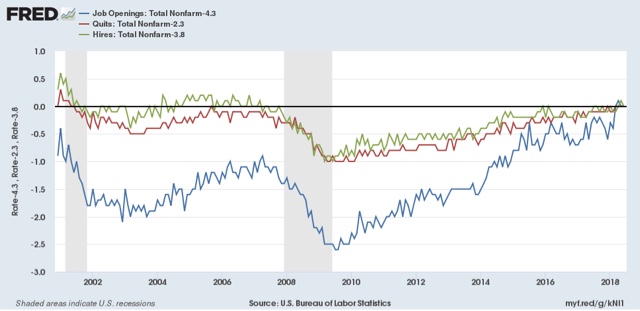- by New Deal democrat
Yesterday's JOLTS report remained excellent, suffering only in comparison to last month:
- Hires were just below their all-time high of one month ago
- Quits were just below their all-time high of one month ago
- Total separations made a new 17-year high
- Openings were just below their all-time high of two months ago
- Layoffs and discharges rose to their average level over the past two years
In short, the JOLTS report for June confirmed the excellent employment report of one month ago.
So let's update where the report might tell us we are in the cycle, remaining mindful of the fact that we only have 18 years of data.
So let's update where the report might tell us we are in the cycle, remaining mindful of the fact that we only have 18 years of data.
Let's start with the simple metric of "hiring leads firing." Here's the long term relationship since 2000, quarterly:
Here is the monthly update for the past two years measured YoY:
In the 2000s business cycle, hiring and then firing both turned down well in advance of the recession. Both are still advancing through the end of the second Quarter this year, and their YoY strength has rebounded.
In the 2000s business cycle, hiring and then firing both turned down well in advance of the recession. Both are still advancing through the end of the second Quarter this year, and their YoY strength has rebounded.
In the previous cycle, after hires stagnated, shortly thereafter involuntary separations began to rise, even as quits continued to rise for a short period of time as well. Here's what that looks like quarterly through midyear 2018 (note: involuntary separations are inverted, and quits are multipiled *2 for scale):
Unlike the 2000s cycle, it looks like involuntary separations may have already made their low for this cycle, while both hires and quits are still increasing. This in no way looks like a late-cycle report.
Finally, let's compare job openings with actual hires and quits. As you probably recall, I am not a fan of job openings as "hard data." They can reflect trolling for resumes, and presumably reflect a desire to hire at the wage the employer prefers. In the below graph, the *rate* of each activity is normed to zero at its June 2018 value:
Looked at this way, the data is very telling. While the rate of job openings is at an all time high, the rate of actual hires isn't even at its normal rate during the several best years of the last, relatively anemic, expansion. Meanwhile quits are tied for their best level since 2001 (at the end of the tech boom).
In other words, in econospeak, "wages are sticky to the upside." In everyday language, there is an employer taboo against raising wages. In response, employees are reacting by quitting at high rates to seek better jobs elsewhere.
In short, the June JOLTS report confirms a thriving employment market, but a market that is not in wage equilibrium, as employers are failing to offer the wages that employees demand to fill openings.



